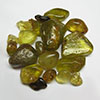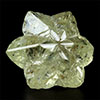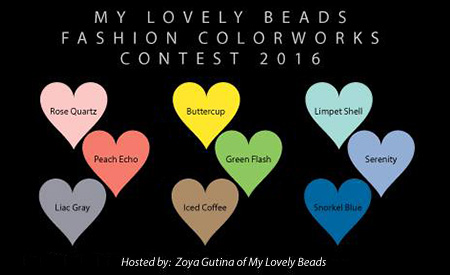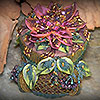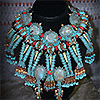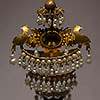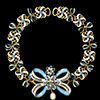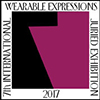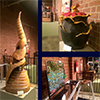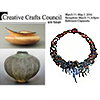March, 2016

From MyLovelyBeads.com with LoveHappy Springtime, dear bead friends! Enjoy flowers blossom and fresh green leaves! Have a seat and read in the March issue of our MyLovelyBeads.com newsletter:
Chrysoberyl - chatoyancy and pleochroism
Contact us with any questions at
info@mylovelybeads.com.
Fashion Colorworks 2016. Ready to start? Finding inspiration and making your own design From Renaissance to Baroque Wearable Expressions 2017 Upcoming events Best regards,
MyLovelyBeads.com Team |
Chrysoberyl - chatoyancy and pleochroismChrysoberyl is a hard, tough, and durable gem. The name chrysoberyl is derived from the Greek words CHRYSOS and BERYLLOS, meaning "a gold-white spar". Despite the similarity of their names, chrysoberyl and beryl are two completely different gemstones, although they both contain beryllium. An interesting feature of its crystals is the cyclic twins called trillings. These twinned crystals have a hexagonal appearance as seen on the second picture. Although lacking the fire of other gemstones, chrysoberyl in its various forms can be quite valuable. Most chrysoberyl gems are yellow, though some are brown, green, or orange, and transparent to translucent. When the mineral exhibits good pale green to yellow color and is transparent, then it is used as a gemstone. The three main varieties of chrysoberyl are: ordinary yellow-to-green chrysoberyl, cat's eye or cymophane, and alexandrite. Yellow-green chrysoberyl has been referred to as "chrysolite" during the Victorian and Edwardian eras, which caused confusion since that name has also been used for the mineral olivine ("peridot" as a gemstone); that name is no longer in use. Alexandrite is a strongly pleochroic gem exhibiting emerald green, red and orange-yellow colors depending on viewing direction in partially polarized light. However, its most distinctive property is that it also changes color in artificial light compared to daylight. Cymophane is popularly known as "cat's eye". This variety exhibits pleasing chatoyancy or opalescence that reminds one of the eyes of a cat. When cut to produce a cabochon, the mineral forms a light-green specimen with a silky band of light extending across the surface of the stone. All colors of transparent chrysoberyl can be faceted into gemstones. Despite its appealing and valuable nature, chrysoberyl is not extensively used in jewelry. The most common colors for chrysoberyl jewelry are yellow, greenish-yellow, and brownish-yellow. "Cat's eye" is polished into cabochons, and usually has a yellow-brown, greenish-brown, greenish-gray, or gray color. Alexandrite is used as rare and exquisite jewelry piece, and most often faceted into round and cushion cuts that are used in rings and pendants. |
|
Fashion Colorworks 2016. Ready to start?This banner was created by Fashion Colorworks 2016 Juror Eva Maria Keiser as a reminder that April, 1 is the first day when MyLovelyBeads.com begins accepting the contest entries! Bead artists have two month to go, the last submission day is June, 10. Are you ready to start or continue? We wish you best of luck!
Fashion Colorworks 2016 rules
|
|
Finding inspiration and making your own designHannah Rosner from Grants Pass, Oregon, USA, is a lampworker and beadweaver. Combining these two crafts, Hannah creates picturesque and multicolored artworks loved by many. Hannah is also a teacher providing workshops at the Bead&Button Show and in Bead Societies all over the USA. We’re glad to have Hannah in our newsletter, meet Hannah Rosner! Hannah says, "My journey to my design work hasn't been a quick one - some of our current designers show up 100% able to put together a piece that screams of THEM. I had a lot of time working before I finally got it together. So when Zoya asked me to write a little article for her, I thought I'd take you on a little journey on what has inspired me. The best way to start work is to learn from the beadworkers and artists you really admire. So, take classes and buy tutorials and kits! However, it becomes more and more important to credit your teachers. I didn't spend a lot of time working small - I went pretty immediately to large scale necklaces and loads of fringe after just a very short stint at stringing semiprecious together. I suggest two really easy ways to find inspiration. The first is to find a color palette that you really admire and work from there. You can find color palettes in a whole bunch of ways. Margie Deeb has written a wonderful book called "The Beader's Color Palette (available on Amazon.com) that gives a whole bunch of design choices that can inspire you. In addition, interior design books are a good source of color inspiration, as are paint chips at any home improvement store. Finally, a wonderful website www.design-seeds.com is a beautiful tool. A multimedia covered box is made in one of my favorite color palettes. The second is to look at lots and lots of famous art. Museums are the best, but if you don't have a good one available, Janson's History of Art (also available on Amazon.com) is a fantastic book with large color pictures. It's expensive but really worth it. The third way I recommend isn't quite as easy but it sure is fun. I suggest traveling! During grad school I visited Prague (which incidentally has a bunch of wonderful museums - SCORE!) and New York City (another bunch of fantastic museums). After I finished grad school, I did a lot of travelling in the Southwest, decided that the scenery and artwork was really inspirational, so finally moved to Taos, NM for a few years. There is a photo of a piece inspired by the Southwest in my gallery..."
Full article by Hannah Rosner
|
|
From Renaissance to BaroqueWith the start of the 17th century Renaissance jewelry evolved gradually into a new style. Soft, flowing dresses with low necklines became the gowns of preference and new jewelry was created to go with the new fashion. Europe was divided by religious conflicts in the 2nd half of the 17th century, and many protestant craftsmen had to flee their Catholic countries of birth and seek asylum in the protestant states. The French court became the new leading fashion trendsetter. International trade flourished which allowed a middle class of merchants and craftsmen to rise and increase their wealth considerably. This allowed the bourgeoisie to start buying the kind of jewelry, which had been reserved for nobles before. The last years of the 16th century and the beginning of the 17th saw a gradual change of appearance in jewelry. The use of arabesque motifs, symmetry and a different type of gemstone setting caused these changes. Figure work eventually fell from fashion and the emphasis on bright colors created with enamel slowly made place for the brilliance of gemstones on gold. Gemstone setting was now focused on highlighting and enhancing the gem, more advanced cutting designs also allowed for a much greater diversity of available shapes. From the end of the second decade of the 17th century jewelry designs started to become more and more naturalistic. This tendency started in France but soon spread over Europe through printed designs. The intensification of the trade with the near East had brought flowers to Europe, which had never been seen before, and exotic flowers became very popular. Flora, fashionable in embroidery since the end of the 16th century, was now adopted by jewelry designers. From the 1650's on engraving in metal was another, and later preferred, way of depicting flowers. In the second half of the 17th century gem mountings became more delicate and the designs moved away from cluster settings to naturalism and ribbon bows. The bow is one of the most prevalent features of Baroque jewelry. Its origin is in the ribbon that was used to secure a jewel to a robe and turned into a popular motif itself. Made of precious metal and decorated with gemstones, pearls and enamel, the bow brooch or pendant is seen on many portraits and designs. By the end of the 17th century asymmetrical bouquets or individual flowers prevailed and the use of enamel diminished... |
|
Wearable Expressions 2017
January 21 - April 16, 2017 A new call for entries came from California, USA! Long time waited, the 7th International Juried Exhibition of Wearable Art "Wearable Expressions 2017" will take place in the Palos Verdes Art Center in Los Angeles area. The goal of the exhibition is featuring wearable art designed for the human body in all media, including jewelry and accessories:
• to promote the fine art aspect
of wearable art media in an international
forum;
• to encourage the creation of innovative art to wear; • to share vision and exploration of techniques and materials. This exhibition is open to adults 18 years or older. The use of innovative materials and techniques is encouraged. The categories are textiles, jewelry and accessories. Along with traditional fabrics, there have been garments created from pinecones, blown glass, metal, paper, electronics, etc. Each artist can submit up to three items for consideration in any or all of the above categories. The entry deadline is October 1, 2016; the exhibition winners will receive prizes of $20,000. |
|
Upcoming events
April 1 - May 1, 2016 The mission and the goal of the Artful Dimensions Gallery are to promote understanding and appreciation of three-dimensional arts. In addition to wonderful works of art in the gallery, they also offer lectures, workshops, individual and small group art classes and cultural events in the space. Creative Crafts Council: On Tour
March 11 - May 21, 2016 The Baltimore Clayworks hosts Creative Crafts Council: On Tour. This exhibition features artists whose work had received awards at the Creative Crafts Council 30th Biennial Exhibition, which originally took place at Strathmore Mansion in June-July 2015. |
|
Note
If you don't see the newsletter properly formatted please click here:
March Issue
|
© 2016 MyLovelyBeads.com All Rights Reserved.
If you do not want receive our newsletter and you wish to remove your email address from our mailing list, please click the following link to unsubscribe.



